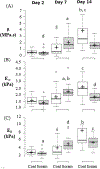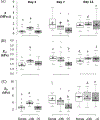The role of adhesion junctions in the biomechanical behaviour and osteogenic differentiation of 3D mesenchymal stem cell spheroids
- PMID: 28577903
- PMCID: PMC6392184
- DOI: 10.1016/j.jbiomech.2017.05.014
The role of adhesion junctions in the biomechanical behaviour and osteogenic differentiation of 3D mesenchymal stem cell spheroids
Abstract
Osteogenesis of mesenchymal stem cells (MSC) can be regulated by the mechanical environment. MSCs grown in 3D spheroids (mesenspheres) have preserved multi-lineage potential, improved differentiation efficiency, and exhibit enhanced osteogenic gene expression and matrix composition in comparison to MSCs grown in 2D culture. Within 3D mesenspheres, mechanical cues are primarily in the form of cell-cell contraction, mediated by adhesion junctions, and as such adhesion junctions are likely to play an important role in the osteogenic differentiation of mesenspheres. However the precise role of N- and OB-cadherin on the biomechanical behaviour of mesenspheres remains unknown. Here we have mechanically tested mesenspheres cultured in suspension using parallel plate compression to assess the influence of N-cadherin and OB-cadherin adhesion junctions on the viscoelastic properties of the mesenspheres during osteogenesis. Our results demonstrate that N-cadherin and OB-cadherin have different effects on mesensphere viscoelastic behaviour and osteogenesis. When OB-cadherin was silenced, the viscosity, initial and long term Young's moduli and actin stress fibre formation of the mesenspheres increased in comparison to N-cadherin silenced mesenspheres and mesenspheres treated with a scrambled siRNA (Scram) at day 2. Additionally, the increased viscoelastic material properties correlate with evidence of calcification at an earlier time point (day 7) of OB-cadherin silenced mesenspheres but not Scram. Interestingly, both N-cadherin and OB-cadherin silenced mesenspheres had higher BSP2 expression than Scram at day 14. Taken together, these results indicate that N-cadherin and OB-cadherin both influence mesensphere biomechanics and osteogenesis, but play different roles.
Keywords: Biomechanics; Cadherin; Mesenchymal stem cell; Suspension culture; Viscoelastic.
Copyright © 2017 Elsevier Ltd. All rights reserved.
Conflict of interest statement
Conflict of interest
All authors declare no financial or competing interests.
Figures







Similar articles
-
Scaffold-free culture of mesenchymal stem cell spheroids in suspension preserves multilineage potential.Cell Tissue Res. 2012 Mar;347(3):701-11. doi: 10.1007/s00441-011-1215-5. Epub 2011 Aug 11. Cell Tissue Res. 2012. PMID: 21833761 Free PMC article.
-
Scalable and cost-effective generation of osteogenic micro-tissues through the incorporation of inorganic microparticles within mesenchymal stem cell spheroids.Biofabrication. 2019 Dec 19;12(1):015021. doi: 10.1088/1758-5090/ab51ae. Biofabrication. 2019. PMID: 31658444
-
Matrix stiffness regulation of integrin-mediated mechanotransduction during osteogenic differentiation of human mesenchymal stem cells.J Bone Miner Res. 2011 Apr;26(4):730-8. doi: 10.1002/jbmr.278. J Bone Miner Res. 2011. PMID: 20939067
-
Role of N-cadherin in bone formation.J Cell Physiol. 2002 Mar;190(3):297-305. doi: 10.1002/jcp.10073. J Cell Physiol. 2002. PMID: 11857445 Review.
-
The role of mechanical signals in regulating chondrogenesis and osteogenesis of mesenchymal stem cells.Birth Defects Res C Embryo Today. 2010 Mar;90(1):75-85. doi: 10.1002/bdrc.20173. Birth Defects Res C Embryo Today. 2010. PMID: 20301221 Review.
Cited by
-
Scaffold-free bioprinting of mesenchymal stem cells using the Regenova printer: Spheroid characterization and osteogenic differentiation.Bioprinting. 2019 Sep;15:e00050. doi: 10.1016/j.bprint.2019.e00050. Epub 2019 Apr 23. Bioprinting. 2019. PMID: 31457109 Free PMC article.
-
Stem Cell Mechanobiology and the Role of Biomaterials in Governing Mechanotransduction and Matrix Production for Tissue Regeneration.Front Bioeng Biotechnol. 2020 Dec 14;8:597661. doi: 10.3389/fbioe.2020.597661. eCollection 2020. Front Bioeng Biotechnol. 2020. PMID: 33381498 Free PMC article. Review.
-
Three-Dimensional Spheroid Culture of Human Mesenchymal Stem Cells: Offering Therapeutic Advantages and In Vitro Glimpses of the In Vivo State.Stem Cells Transl Med. 2023 May 15;12(5):235-244. doi: 10.1093/stcltm/szad011. Stem Cells Transl Med. 2023. PMID: 37184894 Free PMC article. Review.
-
Formation and Developmental Specification of the Odontogenic and Osteogenic Mesenchymes.Front Cell Dev Biol. 2020 Jul 17;8:640. doi: 10.3389/fcell.2020.00640. eCollection 2020. Front Cell Dev Biol. 2020. PMID: 32850793 Free PMC article. Review.
-
The Dynamic Counterbalance of RAC1-YAP/OB-Cadherin Coordinates Tissue Spreading with Stem Cell Fate Patterning.Adv Sci (Weinh). 2021 Mar 8;8(10):2004000. doi: 10.1002/advs.202004000. eCollection 2021 May. Adv Sci (Weinh). 2021. PMID: 34026448 Free PMC article.
References
-
- Cook MM, Futrega K, Osiecki M, Kabiri M, Kul B, Rice A, Atkinson K, Brooke G, Doran M, 2012. Micromarrows—three-dimensional coculture of hematopoietic stem cells and mesenchymal stromal cells. Tissue Eng. Part C: Methods 18 (5), 319–328. - PubMed
MeSH terms
Substances
Grants and funding
LinkOut - more resources
Full Text Sources
Other Literature Sources
Research Materials
Miscellaneous

